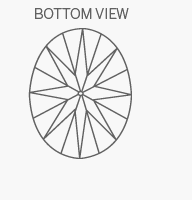The Essential 7C's
Oval Cut Diamonds Shape
Every diamond has its own story, and every lady her own style.
At this point it should be noted that the shape of a diamond can also be referred to as its “cut”, like a round or princess cut. However, this should not be confused with the more commonly used term of diamond cut, which describes how well the diamond has been polished from the raw material (see section on diamond cut).
At Seventy Seven Diamonds we cater to the detailed wishes of every customer and want to ensure that they are well-informed about every diamond shape available. Our selection of beautiful shapes is accompanied by detailed information, images and recommendations on the uniqueness, the history and background, and the ideal ratio of every cut.
Oval Cut Diamonds
1. The Basics | 2. Features | 3. Expert Advice | 4. History
1. The Basics
Somewhere in between the round brilliant and the pear shape...

| Unique Features | Facets | L/W Ratio | Origin | Expert Tip |
| Symmetrical, elongated rounded shape. | Usually 58 | Typically 1.33-1.66 | 19th Century. | Optimises carat weight and elongates finger. |
2. Features



The oval cut is a rounded shape typically comprised of 58 facets with a typical ratio between 1.33 and 1.66.
This shape optimises carat weight, meaning that the drawn out and symmetrical shape can make it appear larger than round stones of a similar weight. The oval cut is also an ideal way to elongate shorter fingers and it has recently become fashionable to use as the centre stone for engagement rings.
A "bow-tie effect" occurs when light passing through the diamond casts a shadow across the central facets of the stone. This shadow can be reduced by altering the depth of the pavilion, and adjusting the angles of the table and facets to better diffuse light in the central area. This effect also occurs in the Pear, Marquise and Heart shapes.
3. Expert Advice
"Ratio is an important aspect to consider with the oval shape as it can have a significant impact on both the light dispersion within the stone and the appearance of the finger. When selecting an oval shape it is important to reconcile the relative benefits of the longer shape (larger ratio) and the more rounded shape (smaller ratio). The former will better elongate the finger, while a more rounded shape will better prevent the bow-tie effect."
4. History & Background
Although oval shaped diamonds were first introduced over 200 years ago, the modern oval cut was invented in the early 1960s by leading Russian cutter Lazare Kaplan. The cut eventually earned him a place in the Jewellers International Hall of Fame, however, Kaplan also left his mark on the diamond industry with his unique ability to split a rough diamond into smaller stones with a single blow. This process is known as cleaving.
When a rough material is poorly shaped or contains defective flaws that prevent it from being turned into a single stone, it must be split along the grain. Kaplan became famous for his expertise in taking stones that were otherwise deemed unworthy and transforming them into beautifully cut diamonds.

Where next?
To view oval cut diamonds offered by Seventy Seven Diamonds, please click here.
To customise your oval cut engagement ring, please click here.
If you would like to read more about diamond education, please click here.

 Round
Round Princess
Princess Cushion
Cushion Oval
Oval Pear
Pear Emerald
Emerald Heart
Heart Radiant
Radiant Asscher
Asscher Marquise
Marquise Trilliant
Trilliant